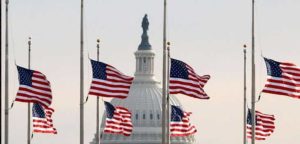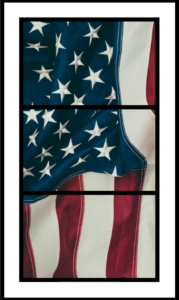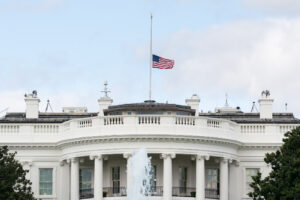Displaying the Flag
A Guide to Proper Flag Etiquette
 Displaying the Flag at Half-Staff
Displaying the Flag at Half-Staff
There are four specific occasions during which the flag of the United States is flown at half-staff, or at the mid-way point of the staff or pole to which it is attached:
- Memorial Day
- Peace Officers Memorial Day
- At the Direction of the President
- At the Direction of a State's Governor
When the flag is flown at the half-staff position, it should be raised and lowered according to the following procedure:
When the flag is hoisted in the morning, it should be raised to the peak (top of the pole) for a few moments, then lowered to the mid-way point on the staff. When the flag is removed at the end of the day, to not lower it from the half-staff position. The person(s) detailed to lower the flag should first raise it to the peak of the staff, then slowly lower it from that point.
Displaying the Flag at Half-Staff on Memorial Day
On Memorial Day the flag is flown at half-staff only until noon. The proper sequence for displaying the flag on this holiday we have set aside to remember the more than one million men and women who have died in defense of our Nation is: in the morning the flag should be attached to the halyard and raised briskly to the top of the flag pole, then slowly lowered to the mid-way point of the pole. At noon the flag should be raised to the top of the flag pole. At the end of the day, the flag should be slowly and ceremoniously lowered and removed.
Displaying the Flag at Half-Staff on Peace Officers Memorial Day
In 1962, the date May 15th was designated as Peace Officer's Memorial Day, "in honor of the Federal, State, and municipal officers who have been killed or disabled in the line of duty. On this day the flag should be flown at half-staff for the full day, unless May 15th happens to also be the third Saturday in May, Armed Forces Day. In the rare occurrences when both holidays fall on the same date, the flag should be flown at the peak.
Displaying the Flag at Half-Staff as a Symbol of Respect
 Upon the death of great individuals or current or former government officials, the President of the United States can direct that the flag be flown from the half-staff position "as a mark of respect to their memory." When respect is thus shown upon the death of current or former United States government officials, the flag is flown at half-staff according to the following:
Upon the death of great individuals or current or former government officials, the President of the United States can direct that the flag be flown from the half-staff position "as a mark of respect to their memory." When respect is thus shown upon the death of current or former United States government officials, the flag is flown at half-staff according to the following:
- 30 Days from the death of the President or a former President
- 10 Days from the day of death of:
- The Vice President
- A sitting or former Supreme Court Chief Justice
- The Speaker of the House of Representatives
- From the day of death to the day of Internment:
- An Associate Justice of the Supreme Court
- The Secretary of an Executive or Military Department
- A Former Vice President
- The Governor of a State, territory, or possession of the United States
- On the day of death and the following day of a Member of Congress
Whenever a present or former official of the State Government dies, the Governor of that State can direct that the United States Flag be flown at half-staff in respect to their memory.
Common Questions
Q: Is the flag only flown at half-staff with respect to the memory of government officials?
A: No. The President can direct that the flag be flown at half-staff as a symbol of respect for great Americans who are noted for their non-government service and achievement.
Q: Is the flag only flown at half-staff with respect to the memory of U.S. Citizens?
A: No. The President can direct that the flag be flown at half-staff as a symbol of respect for other officials and foreign dignitaries.

Displaying the Flag Indoors
There can be no finer part of "interior decorating" than the proud display of the United States Flag. Schools, churches, auditoriums, stores, and just about any inside area is an appropriate places to "Show Your Colors". Sadly, the United States Flag is no longer a universal fixture in our country's Classrooms.
When the National Colors are displayed on a staff mounted to the wall of a room, it should be flown to the right at the front of the room (in a classroom this means to the teacher's right), and any other flags displayed from separate staffs should be to the U.S. Flag's left. If several flags are flown from the same mounting, the National Colors should be centered and hold prominence. When displayed against a wall with another flag on crossed staffs, the National Colors should be in its own right, and the staff of the U.S. Flag should be in front of the staff of any other flag so displayed.
Displaying the Flag on a Platform
 When the flag is mounted on a staff that sits on a platform, the National Colors are placed to the speaker's right (the audience's left), and any other flag(s) similarly displayed on the platform should be to the left of the U.S. Flag. In some occasions, the flags are displayed off the platform and in front of the speaker (making them a part of the audience). In such situations, the position of the U.S. Colors has occasionally been reversed with the National Flag placed to the audience's right. The practice has fallen to general disuse, and such reversal of placement was a matter of custom not specified in the flag code. Should you see such a display, it is not necessarily erroneous.
When the flag is mounted on a staff that sits on a platform, the National Colors are placed to the speaker's right (the audience's left), and any other flag(s) similarly displayed on the platform should be to the left of the U.S. Flag. In some occasions, the flags are displayed off the platform and in front of the speaker (making them a part of the audience). In such situations, the position of the U.S. Colors has occasionally been reversed with the National Flag placed to the audience's right. The practice has fallen to general disuse, and such reversal of placement was a matter of custom not specified in the flag code. Should you see such a display, it is not necessarily erroneous.
To avoid confusion, however, we normally recommend the practice of always placing the flag to the speaker's right.
The flag may also be displayed flat against a wall at the head of a room. The important thing to remember about such a display is the position of the Union (blue field of stars). The flag thus displayed should be positioned so that the Union is always to the flag's own right, or to the left of the viewer. If you are not sure, stand in the entrance to the room and look at the flag, making sure that from your position the Union is to your own left-hand side.
Displaying the Flag in a Hall or Corridor
 When the flag is suspended vertically from a corridor, the field of blue should be to the left of persons as they enter the corridor or hall. If there are multiple entrances to the corridor or hall, then the union should be either facing North (in an east/west corridor), or East (in a north/south corridor).
When the flag is suspended vertically from a corridor, the field of blue should be to the left of persons as they enter the corridor or hall. If there are multiple entrances to the corridor or hall, then the union should be either facing North (in an east/west corridor), or East (in a north/south corridor).
Displaying the Flag in a Window
When the flag is displayed in the window, keep in mind that you are showing your patriotism to people outside your building they are the "audience". This means that the blue field of stars (The Union) should be to the flag's own right when viewed from the street or sidewalk. To make sure you have displayed the flag properly in your window, walk outside and look at it. If the Union is to your left as the observer, your display is properly and correctly done.
 Displaying the Flag at Half-Staff
Displaying the Flag at Half-Staff